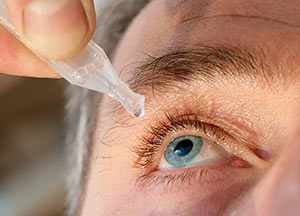AARP Hearing Center
'Epidemic' of Dry Eyes: Blink More, Stare Less
By Candy Sagon, July 12, 2013 08:00 AM
For the past year, my eye doctor has been giving me samples of different over-the-counter drops to help me with the dry, irritated eyeballs I have first thing in the morning and again at

night.
I assumed it was just me with this annoying problem, but evidently there are some 25 million other Americans with the same condition, according to a recent story in the Wall Street Journal.
At least one ophthalmologist said she's seen an "epidemic" of irritated, dry eyes among both her older and younger patients.
"At one point primarily it was postmenopausal women. Now I have all kinds of dry-eye patients," Stephanie Marioneaux, an ophthalmologist in Chesapeake, Va., told the Journal.
A quick check of the drugstore shelves also confirms her diagnosis: The number of products for dry eyes has boomed.
Christopher Starr, an associate professor of ophthalmology at Weill Cornell Medical College in New York, thinks it's because we're blinking 50 percent less as we stare at our cell phones and computers.
"Normally, we blink about 20 times per minute. It can drop to eight or 10 times a minutes," as we become engrossed in looking at those screens, he told CBS News.
Blinking helps spread a soothing film of slightly oily tears across the eye. By blinking less, the eye dries out and becomes irritated. Marioneaux even gives her patients a sticker to put on the computer that says "Blink!" to remind them.
Eye doctors also think that spending a lot of time in low-humidity, air-conditioned office buildings contributes to the problem, along with contact lenses and eye surgery like Lasik or for cataracts. Certain medications can also cause dry eyes.
Finding the right product to treat your dry-eye problem can take a while. As with my case, it often involves trying different products, starting with over-the-counter artificial tears to replenish moisture in the eyes.
Because I was using the drops several times a day, my doctor recommended trying a preservative-free brand because preservatives can irritate the eye as well. As the Journal notes, preservatives are added to some drops to prolong their shelf life and protect against bacteria, but they can cause discomfort.
I ended up finding relief by using preservative-free, lubricant eye drops for sensitive eyes. The drops are packaged in individual plastic vials designed for only one-day's use each.
I also try to follow what Starr calls the 20/20/20 rule: "Every 20 minutes you're on the computer, take a break, look away at a distant object that's 20 feet away or further for 20 seconds or more."
And don't forget to blink.
Photo: BSIP SA/Alamy
Also of Interest
- Drugs to Treat Vision Loss
- Seeing Spots? That Spot May Be a 'Floater'
- Join AARP: Savings, resources and news for your well-being
See the AARP home page for deals, savings tips, trivia and more































































